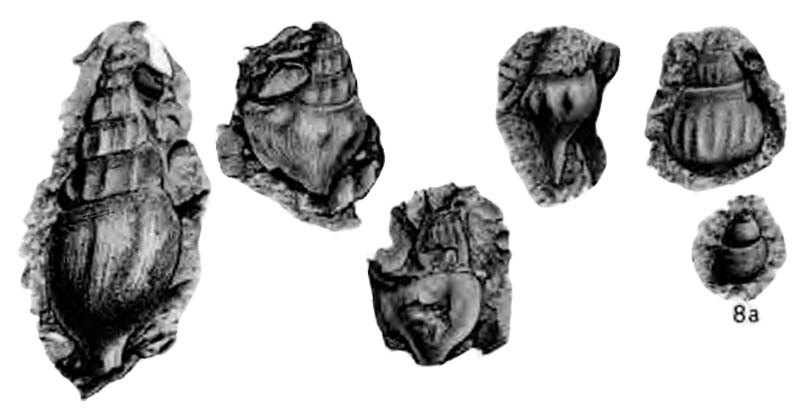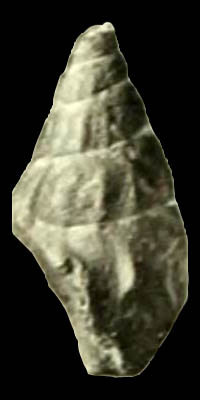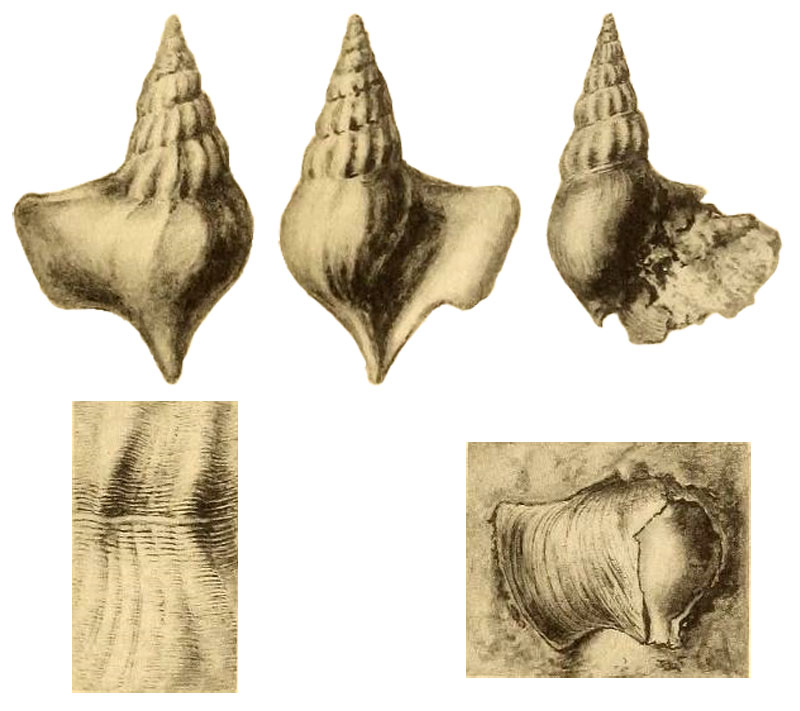|
edit SideBar
|
Stromboidea
Original Description of Alaria(?) Bailyi by Etheridge, 1904, p. 83:
- "Shell fusiform; spire elevated, of umerous whorls (eight or nine); apex obtuse, pupa-like. Whorls moderately convex; body-whorl elongately fusiform, expanding into a broad flattened wing, with a rounded and entire margin, the posterior angle obtusely pointed, and no carinae; sutures shallow. Inner lips slightly reflected; anterior canal moderately long, straight; posterior canal none. Sculpture consisting of very delicate and regular thread-like lines extending over the surface of all whorls, but more conspicuous on the posterior portions of the anterior whorls contiguous to the sutures; the four or five posterior whorls bear no costae, but the remainder (anterior) carry regular, equidistant slightly curved ribs, which on the body whorl degenerate into obtuse, elongated tubercles; the intercostal spaces carry fine lines of growth, interrupting the spiral threads on the wing, the spiral threads have an uneven or fluctuating appearence."
 Alaria (?) Bailyi Etheridge, 1904, pl. II, fig. 4-8
Comment Etheridge, 1904, p. 84:
- "Portions of this shell are common throughout the deposit, although no absolutely perfect example is present. The wing is without digitations, but terminates at its upper or posterior angle in an obtuse or somewhat thickened point. The margin of the wing is rounded and entire, and there is no carina on the body-whorl. Some forms of Alaria possess costae on the body whorl - e.g. A. rostrata, Gabb, apparently without carinae leading to alar digitations. Although perhaps not a typical Alaria, the present species appears to coincide with the characters of that genus better than with those of any other. Had it not been for the presence of the long anterior canal, I would have felt disposed to refer this shell to Arrhoges, Gabb, from the presence of the obtuse posterior termination of the wing, and the all but entire absence in Arrhoges of a posterior canal. In the structure of its posterior whorls A.(?) Bailyi exhibits a strong resemblance to A. papilionacea, Goldf., as developed in the Indian Trichinopoly Group, but the presence of costae on the body-whorl of the former at once separates the two forms. A.(?) Bailyi is in no way related to A. coronata, Tate of the Uitenhage formation."
History and Synonymy
1914
Aporrhais cf. bailyi in Spengler, 1914, pl. XV, fig. 2
1930
Dicroloma (Perissoptera) bailyi in Rennie, 1930, pl. XXV, fig. 11-15
References
- Akopyan V.T. (Ed.) (1974) Atlas of fossils of Armenian SSR. Erevan: Ac. Sci. Arm.SSR. 838 p. [in Russian]
- Etheridge, R. jun. 1904. Cretaceous Fossils of Natal, Pt. I, the Umkwelane Hill Deposit, Zululand in William Anderson: Second Report of the Geological Survey of Natal and Zululand. West, Newmann & Co., London 1904, pp. 69-94, Fulltext
- Hakopyan (Akopyan), V.T. (ed.) 1974. Atlas of the fossil fauna of Armenian SSR
- Rennie, J.V.L. 1930. New Lamellibranchia and Gastropoda from the Upper Cretaceous of Pondoland (with an Appendix on some Species from the Cretaceous of Zululand). Annals of the South African Museum, v. 28, pt. 2, p. 159–260, pls. 16–31, Fulltext
- E. Spengler, 1913 [1914]. Nachträge zur Oberkreidefauna des Trichinopolydistriktes in Südindien; Beitr. z. Geol. u. Pal. Oesterreich-Ung. u. D. Or. XXVI(III-IV) p. 1-27 [213-239], Fulltext
|



